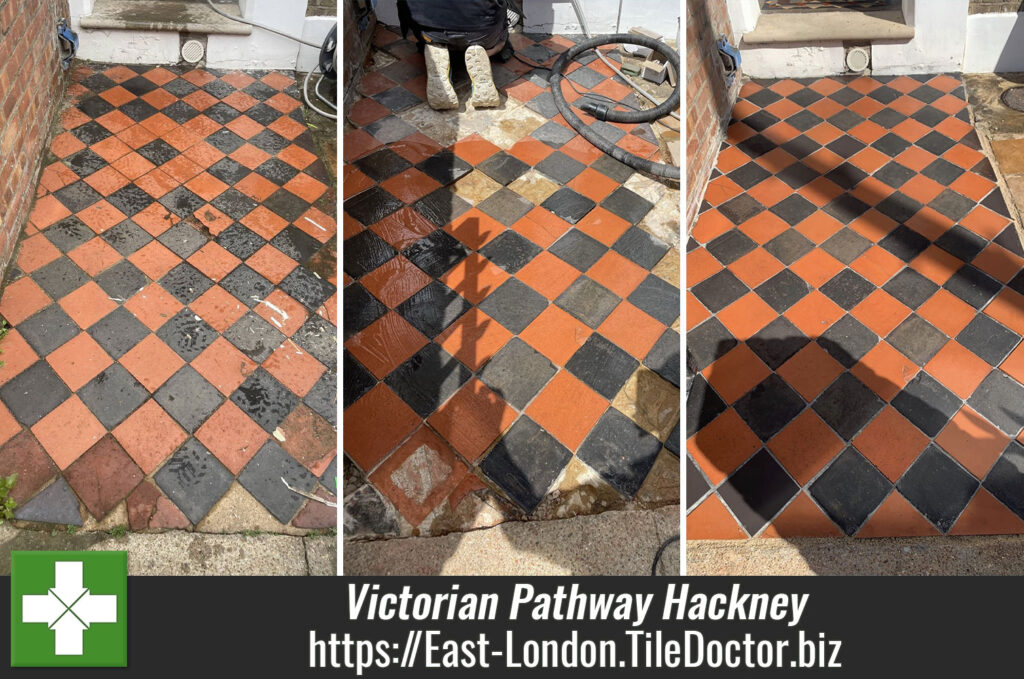Red and Black Victorian Tiled Pathway Restored in Hackney East London
The picture below is of a Red and Black Victorian Path leading up to a house in Hackney; which according to my client had never been maintained since they moved in and that was 31 years ago.
The years had taken their toll on the tiles and the path had numerous problems including missing and damaged tiles, grout was missing or had fallen out, the colours in the tiles had faded, weeds were growing through and at some point in its long history a repair had been made which had messed up the pattern.

It always makes a pleasant change to be asked to carry out work outside especially given then hot temperatures we have experienced in the Southeast recently; however, you do have pick the right weather window. I inspected the path and discussed with the client the process needed to renovate it. They were happy to go ahead with my quote and we arranged a time to return later in the month keeping one eye on the weather as a nice dry day would be needed.
Repairing a Black and Red Victorian Tiled Path
Being outdoors, for a change we didn’t need to tape any surrounding areas to protect them from the clean, so we were able to get straight on with repairing the path. This started by carefully lifting out the damaged tiles and the cement which had been used to backfill the places where tiles were missing. At this point I could see 15 tiles would need replacing in total.
I also dug out the channel between the adjacent Sandstone patio and the Victorian pathway so it could be tidied up. The foundation was cleaned up and I was ready to lay out the replacement tiles in a matching pattern to ensure a good fit and that they would be level with the surrounding tiles. I also sorted out the pattern making it an even, symmetrical design throughout the path.

Once I knew everything would fit, the tiles were all set in position used a slow setting adhesive that would allow for a few corrections as it went off. Before leaving for the day, I grout in the tiles using a smoke grey grout colour and left instructions for no one to walk on the path.
By the end of the first day the path was looking much healthier.
Deep Cleaning a Black and Red Victorian Tiled Path
The second day was all about cleaning and with the adhesive set I was able to give the whole path a mechanical scrub with a coarse 50-grit Diamond pad lubricated with a dilution of Tile Doctor Pro-Clean with is a strong alkaline cleaner. This combination really gets into the pores of the tile to lift out the ingrained with dirt. The soiled cleaning solution was the vacuumed away with a wet vax and the process repeated with a 100 and then a 200-grit diamond grit pad but with just water this time. The finer pads refine the finish of the tile after the application of the coarse 50-grit pad. After another rinse and extraction, the floor was inspected and worked on the really bad tiles using a set of diamond blocks to get right into the dirt.
Last step in the cleaning process was to give the tiles an acid rinse using a strong dilution of Tile Doctor Grout Clean-up which does a number of things including neutralising the ph level of the tile, countering any efflorescent salts in the floor and cleaning off grout smears.
My final step for the day was to fill in the channel between the Sandstone patio and the pathway with some an Easy Joint compound in a mushroom colour.
Sealing a Victorian Tiled Pathway
The dry weather continued so I was able to return the following day to seal the tiles and protect them from the weather. The tiles need to be dry before being sealed so their moisture readings were taken with a damp meter. The meter showed little to no moisture which was perfect. The weather helped massively in this process although it was a little too hot for me sometimes!
I used Tile Doctor X-Tra Seal to seal the floor, it’s an oil-based sealer that enhances colour and structure in the tile to bring out the Red and Black colour, its fully breathable and has built-in UV protection. Due to being outside and exposed to the sun this was clearly the best sealer for the job. I put 1 coat on, buffed off the excess and then left it for half an hour before putting another coat on.

The path looked new by the time I had finished, and I had a very happy customer who has now asked me to quote for a clean of their back garden patio.
Professional Restoration of a Victorian Tiled Pathway in East London
Red and Black Victorian Tiled Pathway Restored in Hackney East London Read More »











